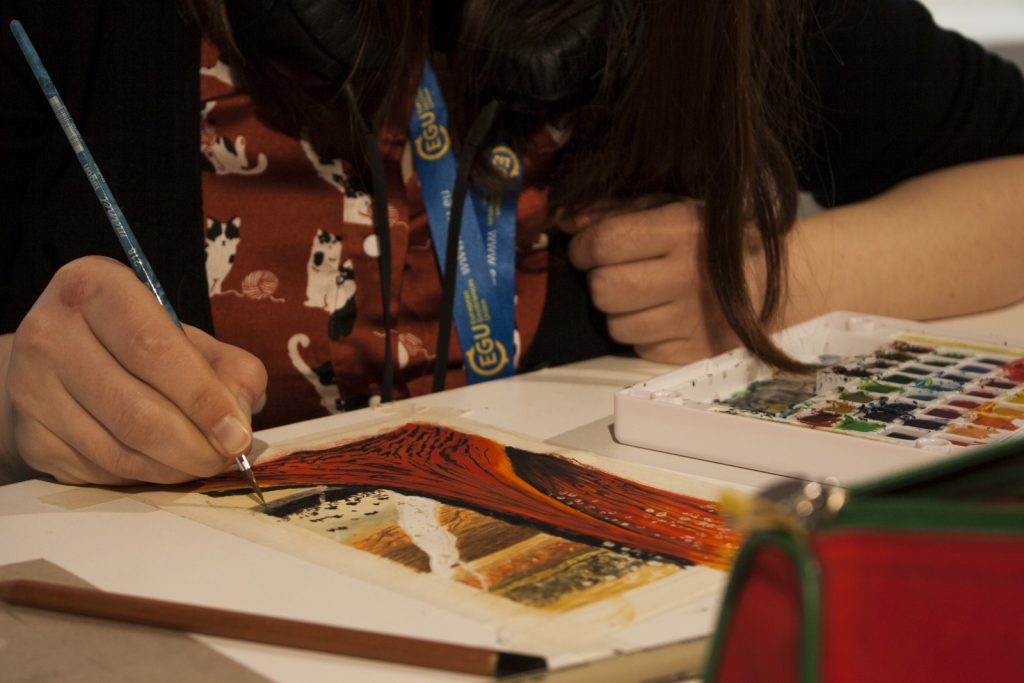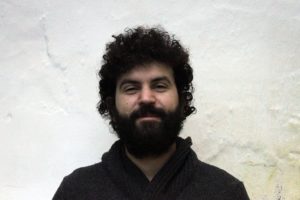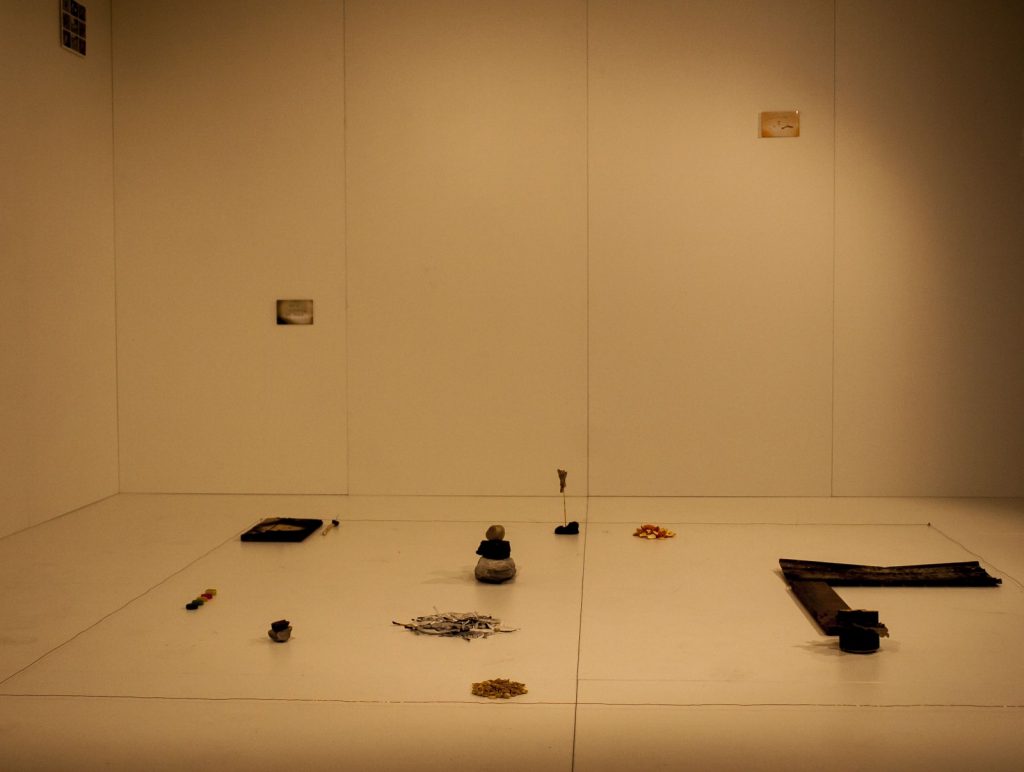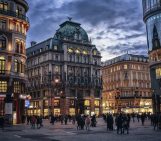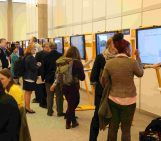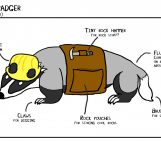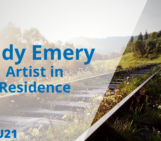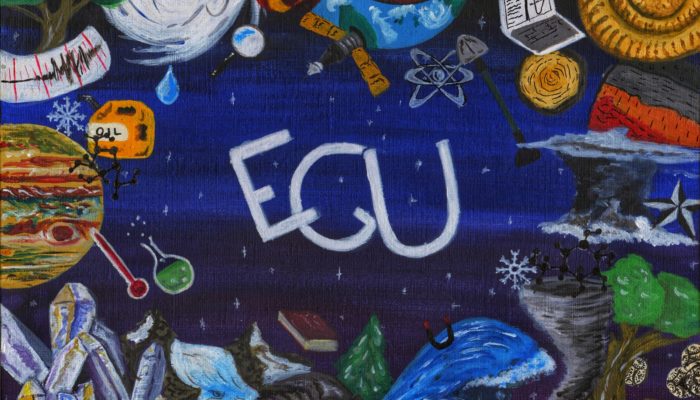
At the annual EGU General Assembly in April, more than 16,000 scientists from 113 countries convened in Vienna to share exciting research and discuss the latest advances in their field. During this conference, the EGU hosted two artists in residence to engage with scientific research in a dynamic setting and be inspired by new scientific discoveries. This year, we interviewed the 2019 artists in residence, Morgane Merlin and Giorgo Skretis, on their General Assembly experience, their relationship with art and science, and their views on how art can be used to bridge the gap between science and society.
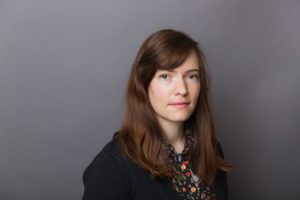
Merlin is an environmental science PhD student and visual artist based in Alberta, Canada. Credit: M Merlin
Morgane Merlin
Merlin is an environmental science PhD student and visual artist based in Alberta, Canada. She works with a variety of media, including watercolours, acrylics and pastels. At the meeting, she focused on creating illustrations based on the main research results of selected presentations.
You are a scientist; how did you start drawing?
I have always drawn my whole life, so it’s been something that I did as a kid. I kept it up through school, and then after high school there was a point I had to decide if I wanted to go more towards the art school or to go towards the science path. I made the decision to go into science so I went to a science school university and now I am doing my PhD, but I always kept the art as something that I did in my past time, something that I wanted to put effort in. It has always been part of my life and I have been trying to incorporate [the] scientific part of my life so the EGU [General Assembly] was a great opportunity to do so.
What do you think that art and science have in common?
They both look at the environment that surrounds us. We just look at it differently. In science we are trying to understand what we are seeing, which is the natural environment for me, my research area, but in art it’s kind of the same, it’s how we perceive our environment around us. So they have very similar missions, but very different ways to communicate it. The science part can definitely gain some artistic perspective to be able to communicate more with the public…
From art and science, which one you enjoy the most?
That’s a tough question! It’s really tough because I really enjoy both of them. With the science I really enjoy doing experiments, finding some really new and exciting results, but at the same time, some days you need a break, so then that’s when I turn to art. And I really enjoy it, just take a step back and sort of focus on myself and a more down-to-earth activity I guess, by just drawing. Both of them bring a lot of joy, but they satisfy different parts of me.
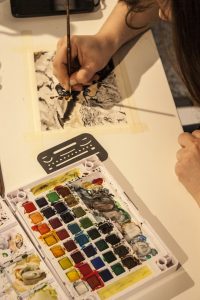
The tiny menace of bark beetles for our forests. Artwork by Morgane Merlin. Photo from Anastasia Kokori
What can art bring to science? What are the benefits of art on science? What can science bring to art?
I think art can bring a lot in terms of just changing our perspective as scientists. Sometimes as scientists we get blocked down into the data and the analysis, and by trying to reach out and link it with arts, we can just take a step back and try to refocus on what it means and how to communicate that. With arts you can really focus on how to best communicate your message. People respond to different colours, different designs, and I think by incorporating some art concepts into our scientific communication, we can definitely improve on how we communicate our results, how we see our own results to better involve the public, for example, and just understand why we do that.
As an artist in residence, how was the experience at the EGU General Assembly? How do you feel?
This was my first time doing this kind of artist in residence thing. It was definitely kind of scary at first because I have never done this. I have been usually doing my art in the privacy of my own home; no one really saw me painting or drawing in my life, but it has been a really wonderful experience to see how open people are to see something different.
We may see the scientific community as very focused people and they only understand science, but a lot of them have a lot of things going on. I have discussed with a lot of people, [and] many people are just interested in just having a very quick chat about what I am doing here but also that themselves actually have drawn in the past time or they play music, or they did other things like that. So it has been a great experience for me as both a scientist and an artist to put myself outside there and just have a lot of good interactions with the people that came to the conference.
It is a big conference, I had people that were just stopping, coming to look, because it’s something different from what you expect from a scientific conference. So, lots of people just browsed, looked what I have been doing, and looked some of the paintings I have. About 75 percent of them also just stopped and asked me what I am doing here because they were not aware of this. Overall all these interactions made me feeling confident in bridging these two parts of my life, science and art. It has been a very diverse and exciting experience.
How can art be used to bridge the gap between science and society?
I think art and bringing art into a scientific context can definitely help with communicating scientific results to the public because lots of artists are part of the general public, they don’t have a background in science. So by bringing artists and scientists to collaborate together in projects, I think this definitely helps communicating the science to the public and increase the efficiency of outreach.
Artists have this very visual representation. The whole thing is based on communicating to the public. When you put together artists and scientists with scientific results that [are] sometimes very hard to communicate, art is this sort of middle man that can help you translate the very jargon heavy scientific results to what is going to be understood by the public.
Do you have any further ideas or recommendations to improve the collaboration between art and science?
What I would suggest for the future, maybe having small panel sessions where the artists with the scientists can really engage with each other at a more intimate level by having structured sessions. Maybe with these sessions, both the artists and the scientists could complete something together and produce some art piece or artwork together and then being exhibited during the last days of the conference, for example, to promote the engagement of both the artists and the scientists.
Giorgio Skretis
Giorgo Skretis is a visual artist and musician based in Chania, Greece. During his residency, he created a small collection of sculptures using natural materials such as clay and plaster. The form and manner of creation of these sculptures reflected the various processes and forces of nature, with a focus on themes presented at the meeting.
As an artist, how did you become interested in science?
I have a small background in science; I also studied for a few years for an electrical engineering degree but I decided to stop in order to get engaged with art. But I have always been interested in science related issues. And this was going into my art in the past. In terms of sculpture, my interest is the object of science, the Earth processes. I am interested in all the processes and how matter changes when it is wet, or when it hot, or dry, all this kind of these things.
As a professional artist, what inspired you to go into science?
I am interested in the way that materials change and the different processes in nature, for example how land lies, or the earth falling, or the sediments. So in a relation to art, how you can use these Earth related processes to talk about the human condition.
What was the reaction from the public at the EGU General Assembly?
I had a range of people that couldn’t understand exactly what I was doing here, people that could really relate with what I was looking at, and let’s say the outcome. I had many people who came to me and we had interesting conversations about my subject that was on the use of materials and Earth resources by humans, the impact of this use and the extent to which we can control or limit or use the benefits of the wider ecosystem. There were people that just came and expressed their appreciation for the visual aspects of it.
What were the highlights from this year at the EGU General Assembly?
I have been hearing so much [at] this conference on how art can be used as an outreach method for scientists and I am sure it can work to this direction.
Through meeting different people, some ideas for future collaborations came up and I would love to join again as an [EGU artist in residence]. I think a big surprise was also the sculpture workshop that I ran, and there were lots of interested people to participate and they wanted to explore their research interests with materials such as clay. So it shows that the split fields of arts and science get more and more closer.
Interview by Anastasia Kokori, EGU Press Assistant
You can follow the art work produced by Merlin and Skretis via social media (using the hashtag #EGUart) and on GeoLog.

